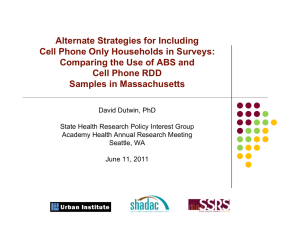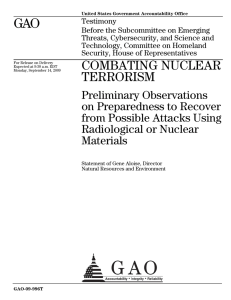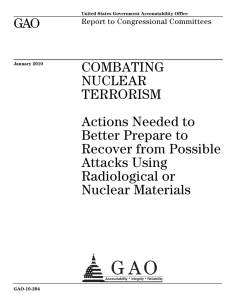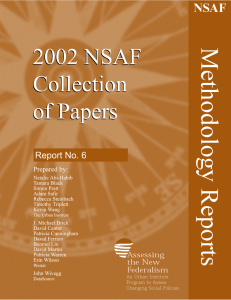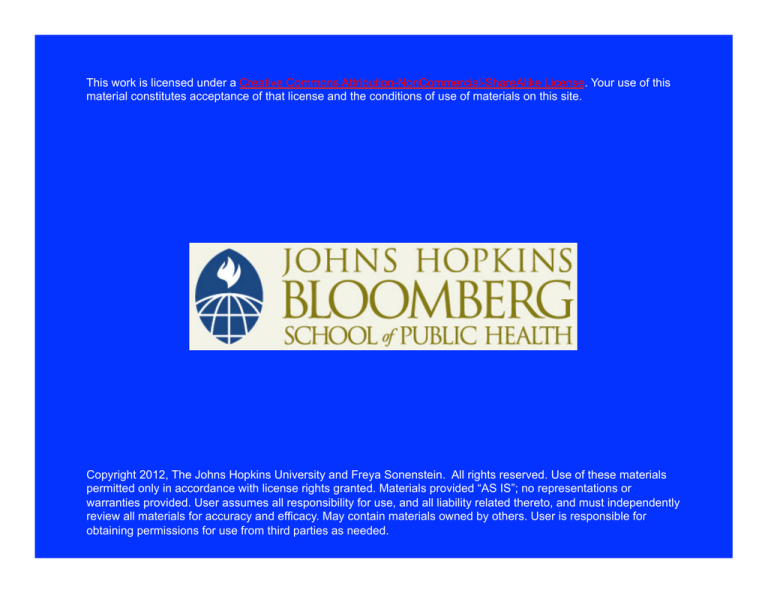
This work is licensed under a Creative Commons Attribution-NonCommercial-ShareAlike License. Your use of this
material constitutes acceptance of that license and the conditions of use of materials on this site.
Copyright 2012, The Johns Hopkins University and Freya Sonenstein. All rights reserved. Use of these materials
permitted only in accordance with license rights granted. Materials provided “AS IS”; no representations or
warranties provided. User assumes all responsibility for use, and all liability related thereto, and must independently
review all materials for accuracy and efficacy. May contain materials owned by others. User is responsible for
obtaining permissions for use from third parties as needed.
Choice of Collection Method:
The Telephone Survey
• Depends on
– Target population
– Concepts of interest
– Available resources: time and $
• Linked to:
– Sampling strategy
– Design of measures
– Survey Management
Telephone Sample Selection
• List Samples : Coverage error?
– Telephone Directories
– Other directories
– Other lists with respondents phone numbers–
land lines and cell phones
• Random Digit Dial
Waksburg-Mitofsky Two Stage
Method—Random Digit Dial
--area code
--central office code
---four -digit number
First Stage: Clusters of area code/central office code-primary
sampling unit
Second Stage: Numbers within clusters
First Stage RDD
• Secure list of all area codes and prefix or central
office numbers Bellcore’s computerized data
base
• Determine how many clusters will be used typically 50-100
• Using random selection- create primary sampling
units of clusters- area code and central office
codes
• Randomly assigned 4 digits to create ten digit
numbers- identify phones with working numbers
Second Stage- RDD
• Clusters that have working numbers
retained for next stage 410-971-3072 is
within cluster 410-971-3000 to 3099
• Clusters with working numbers- last three
digits are added and numbers randomly
sampled for interviews
• Calls made until desired sample size is
reached
Benefits of RDD strategy?
• Multi-level sampling strategy reduces calls
to non-working numbers and non residential
numbers?
• Includes unlisted households
• What kinds of error do these examples
above describe?
• Other benefits: $, quality control, etc
Disadvantages
• Cannot be used for cell phone calls—24.9% cell
only households 2009
– What kind of error results from this?
– Potential for bias?
• Response rates to telephone surveys rapidly
declining
– Answering machines
– Proliferation of sales calls– do not call lists
– Caller id
• Breakoffs more common
• What about multiple lines per household?
Adding Cell Phones
• Can use modification of WaksburgMitofsky approach (need more cases to
exclude dual households)
• Need to hand dial
• Cost burden for the respondent
• Lower response rate
• Context of call may not be in a residence
• SMS texting options
BRFSS
Hu, S. S., et al. (2011) Improving public health surveillance using a dual-frame survey of landline and cell phone
numbers. American Journal of Epidemiology 173:703-11
Hu, S. S., et al. (2011) Improving public health surveillance using a dual-frame survey of landline and cell phone numbers. American
Journal of Epidemiology 173:703-11
Improving telephone response
rates
• BFRSS
– Prenotification letters and messages on
answering machines (raises response rate 6%)
– Mail followup survey– increases underrepresented groups (reverse directories yield
50-70% address matches)– being tested
– Advantages– adding cell phone only adults
shifts health indicators
•
Telephone: Constructing
Interviews
Needs of respondents
– pronunciation of words
– pace of interview
– interview interruptions
– response categories must match R’s cognitive ability
• Needs of interviewers
– transcripts and transitions
– simple words
– format-layout that flows
• Needs of coder/researcher
– Complexity of programming interview
Strategies
• Emphasis on 1st few questions- early
respondent engagement can reduce
termination
• Conversational introduction example
(Houtkoop-Steenstra, et al)
Multi-mode Strategies
• Can produce a study that maximizes
advantages and minimizes disadvantages
• The National Survey of America’s Families
Example– see www.urban.org
-- purpose to monitor well-being of
America’s families, especially low income
families
NSAF
• RDD survey of households with children-with
oversample of low-income families—(why the
oversample?)
– Telephone screening is the most efficient approach to
identifying eligible families
– Samples needed of families in 13 states so that analyses
could be conducted separately by state as well a sample
of US families
– Therefore large sample sizes required
• What are major disadvantages of this approach?
• To complement the telephone survey– and
in-person survey of non-telephone
households was added to the study
-Challenges—identifying non-telephone
households
-Combining two samples– increased survey error
—why?
Controlling for Mode Effects
• Used in-person screening of households
• Followed by cell-phone interview
– Advantages: R experienced same interview as
RDD sample; Same level of quality control
– Disadvantages: Practical problems with cell
phone coverage—especially in the mountains
Addressing Response Rate Problems
•
•
•
•
•
Advance Letter and Brochure
Building on Family’s interest in the topic
Federal Express advance letter
Incentives
Second short survey of non-responders









